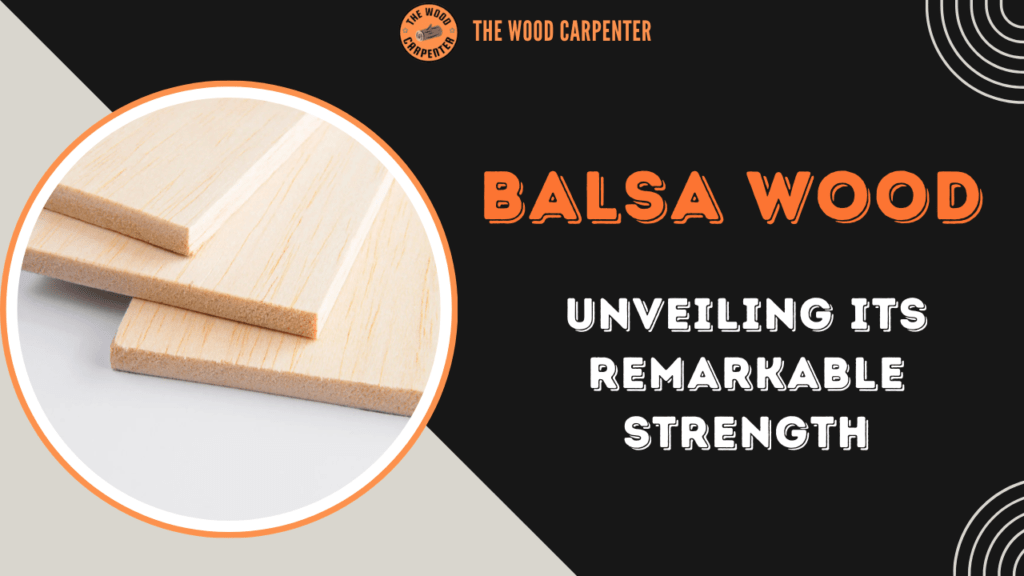
Introduction
About Balsa The few references to this wood on the internet are confusing. Though soft to work with, when it hardens, it is known for its strength and is commonly found in aviation, modeling industry & craftwork.
In this article, we explore everything about balsa wood – its characteristics, uses, pros and cons, and types so you can fully comprehend its capabilities.
What is Balsa Wood?
The balsa wood is from the balsa tree, or Ochroma pyramidale. It is found in Central and South America (especially Ecuador, which is the largest exporting country of balsa wood).
This is a fast growing tree, which means that it can puts on 60-90 feet of height in 6-10 years. Balsa’s distinctive cellular structure gives it a combination of strength and light weight that makes it ideal for use in a variety of lightweight applications.
Properties of Balsa Wood
Balsa wood has several characteristics that make it ideal for many applications:
Low weight – One of the lightest commercial woods, with a density of 160 kg/m³.
Strength-to-Weight Ratio – For structural use as a load carrying product, it is strong enough despite its lightness.
Soft/ Easy-to-Cut — Suitable for carving, shaping, and model making.
Porous Design – Enables easy absorption of adhesives, paints, and coatings.
Natural Insulation – Great for both insulating the sound and the heat.
Advantages of Balsa Wood
- Light weight – Balsa is the lightest wood in the world—the original density chart puts Balsa at 7-9 pounds per cubic foot, about the same as corks, so your projects will practically float away with this balsa!
- Strong For Its Weight – It may be soft, but it can handle impressive loads for its mass.
- Grows Fast & Eco-Friendly– Unlike hard woods, which take decades to mature, balsa trees are a fast growing resource that’s sustainable too!
- Excellent Shock Absorption -It has large applications and can be used to reduce noise shock used in the aerospace industry and armor.
- Non-Toxic & Craft Safe – Great for school projects, model airplanes, and other DIY projects.
Disadvantages of Balsa Wood
- Very Absorbent – It sucks up water fast and swells and weakens.
- Flammable – Ignites quickly as it is naturally very light and porous.
- Non Wetherproof – Needs to be sealed or treated to resist moisture.
- Costly as a Softwood – Pricey to Buy As soft as balsa is, it is costly because it is in demand.
- Out of all the most expensive wood, this wood is even not good on durability if unprotected it will wear out fast.
Common Uses of Balsa Wood
- Model Building – For use with remote control airplanes, boats, and structures.
- Aircraft Building – Used in ultralights and other early plane models.
- Surfboards & Sports Equipment – Lightweight but very strong, perfect for Surfboards and Fishing Rods.
- Crafts & DIY Projects – Most commonly used by hobbyists for general carving and shaping.
- Insulation Panels – Because it is porous, it is used in the insulation of heat and sound.
Balsa Wood vs. Other Woods
| Feature | Balsa Wood | Pine Wood | Mahogany |
|---|---|---|---|
| Weight | Very light | Medium weight | Heavy |
| Strength | High (for its weight) | Strong | Very strong |
| Workability | Very easy | Moderate | Difficult |
| Durability | Low | Medium | High |
| Cost | Expensive | Affordable | Expensive |
Why is Balsa Wood Used in Aircraft?
Balsa wood was widely employed in early aircraft because of its low weight and high strength to weight ratio. Today also, certain aircraft models and parts use balsa wood for internal structures.
How Strong is Balsa Wood?
Balsa wood looks so frail because it is so soft, but the compressive and tensile strength of it for its density is actually quite respectable. It is able to lift a load of up to 40 times its weight, for instance.
How to Protect Balsa Wood?
Because balsa wood is so porous and tends to soak up moisture, it must be sealed in order to be treated to last:
- Apply Varnish or Epoxy – Creates a protective coating against moisture.
- Use Paint or Wood Stains – Adds color and enhances longevity.
- Keep Away from Water – Store in dry conditions to prevent swelling.
FAQ Section
1. Is balsa wood real wood?
Balsa is indeed a natural hardwood! Soft and light, but it still counts!
2. Why is balsa wood so light?
Balsa is a birch wood that has large air spaces in its cells, and is also very light.
3. What is balsa wood used to make in the construction?
It utilized for insulation panels, fireproof constructions and composite materials.
4. Is balsa wood waterproof?
No, the balsa is very soft and will soak moisture.
5. Does balsa wood break easily?
Yes, it is also able to break under extreme pressures, granted strong for its weight.
6. What is the purpose of using balsa wood in planes?
Being lightweight and strong, it can be used in aircraft interior applications and model applications.
7. Is it possible to use balsa wood in furniture?
Not generally as it’s a bit too soft and weak for most heavy furniture.
8. How strong is balsa wood?
It has a high strength-to-weight ratio but not as high as hard woods such as oak or maple.
9. What kind of wood is balsa?
Its botanical name is “Ochroma wood” which means light weight.
10. Can balsa wood be recycled?
Yes, it is biodegradable, and yes, it can be recycled!
11. What are RC planes made of?
Balsa wood is commonly used in RC planes because it is lightweight.
12. Is balsa wood flammable?
It is indeed so flammable that even at high temperatures it can be ignited by a spark.
13. Is it possible to cut balsa wood with a knife?
Yes, you can easily cut it with a hobby knife or razor blade.
14. What is stronger than balsa wood?
Hardwoods such as oak, maple, and teak are much heavier than balsa.
15. What are some inexpensive options to balsa wood?
Foam board, plywood, basswood are also often substituted.
16. How heavy is balsa wood?
It has a density of about 10 to 20 pounds per cubic foot, which means that it is one of the lightest of the commercial woods.
17. Why is balsa wood expensive?
Because this tree is fast-growing, but in great demand in niche markets, it is pricey.
18. Can you stain or paint balsa wood?
You can but you would need a primer or sealer to stop the excess absorbtion.
19. What is the best glue for balsa?
Good old wood glue, cyanoacrylate (super glue), and epoxy are the best bets.
20. How does balsa compare to ply wood?
Balsa is lighter, but not as strong and waterproof as plywood.
Final Thoughts
Balsa is an intersting product it is light, strong and floats! Whether glued to model airplanes or boats, crafts or as insulation, it has remained a standby to many industries. Nevertheless, it is arid and combustible so should be well protected and manipulated. Knowing these characteristics is how to best utilize balsa wood in different applications.

